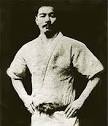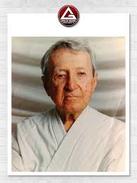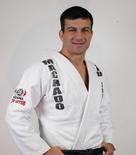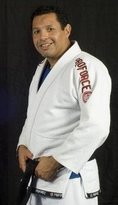
Mitsuyo Maeda was one of five of the Kodokan's top groundwork (newaza) experts that judo's founder Kano Jigoro sent overseas to demonstrate and spread his art to the world. In 1917 Maeda accepted Carlos as a student and Carlos learned for a few years, eventually passing his knowledge on to his brothers. Maeda was fundamental to the development of Brazilian Jiu-Jitsu, including through his teaching of Carlos Gracie and others of the Gracie family. He was also a promoter of Japanese emigration to Brazil. Maeda won more than 2,000 professional fights in his career. His accomplishments led to him being called the "toughest man who ever lived" and being referred to as the father of Brazilian Jiu-jitsu.

Brazilian Jiu-Jitsu, a self defense system that focuses on grappling. Brazilian Jiu-jitsu was formed from Kodokan Judo ground fighting (newaza). Brazilian Jiu-jitsu eventually came to be its own art through the experiments, practices, and adaptation of judo through Carlos and Hélio Gracie.
Brazilian Jiu-jitsu promotes the concept that a smaller, weaker person can successfully defend against a bigger, stronger assailant by using proper technique, leverage, and most notably, taking the fight to the ground, and then applying joint-locks and chokeholds to defeat the opponent. Brazilian Jiu-jitsu training can be used for sport grappling tournaments (gi and no-gi) and mixed martial arts (MMA) competition or self-defense. Sparring ("rolling") and live drilling play a major role in training.
Hélio Gracie gradually further developed Gracie Jiu-Jitsu as a softer, pragmatic adaptation from judo that focused on ground fighting, as he was unable to perform many judo moves that require direct opposition to an opponent's strength.

Carlos Gracie (September 14, 1902 – October 7, 1994) along with his younger brother Hélio Gracie, and fellow students Luis Franca and Oswaldo Fadda are credited with being the primary developer of modern Jiu-Jitsu. Carlos Gracie acquired his knowledge of Jiu-Jitsu by studying in Belem under Maeda and his students. As he taught the techniques to his brothers, he created a martial arts family with Hélio and with other members of the Gracie family who provided key contributions to the style. Carlos Gracie refined his system by fighting in matches that were open to all skill levels and learning from those experiences to make Jiu Jitsu more effective. Some reports claim that he advertised in newspapers and on street corners for new opponents upon whom to practice but no documented records of this exist. Gracie claimed to have fought anyone and everyone who was willing, regardless of size, weight, or fighting style. Though he was 135 pounds, his style proved so effective that Carlos Gracie was never defeated making him a legend in Brazil.

Although the Gracie family is typically synonymous with Brazilian Jiujitsu,, another prominent lineage started from Maeda via another Brazilian disciple, Luiz França. This lineage had been represented particularly by Oswaldo Fadda. Fadda and his students were famous for influential use of footlocks and the lineage still survives through Fadda's links with today's teams such as Nova União and Grappling Fight Team. França would begin training under Mitsuyo Maeda at the same time as Carlos Gracie. After his time with Maeda, França moved to Sao Paulo where he continued his training under Geo Omori. After his stay in Sao Paulo, França would finally settle in outskirts of Rio de Janeiro, where he would begin teaching what he had learned to police officers, military servicemen, and especially the poor in the favelas.

Carlos Machado is an ex world master's champion in Brazilian Jiu-jitsu (BJJ) born in Rio de Janeiro, Brazil. He is the eldest of the five Machado Brothers, that also includes Roger, Rigan, Jean Jacques and John. He is also the brother-in-law of UFC fighter Stephen Thompson. He currently runs Brazilian Jiujitsu schools across the United States. Carlos (born November 9, 1963) started martial arts at the age of four. His main instructor throughout his life was his cousin Carlos Gracie, Jr. but he has also trained with Helio Gracie, Carlson Gracie, Rolls Gracie, Rickson Gracie, Crolin Gracie, Rillion Gracie and his brothers. While in Brazil, he has successfully competed in several tournaments at state and national level

Alvis Solis, 3rd degree Blackbelt in Brazilian Jiujitsu under Carlos Machado. Now 4th degree. Founder of Solis Martial Arts Academy. Started formally in martial arts under Reno Lumampao in Simplified Modern Arnis. He achieved a purple belt rank in his system, before moving to Houston. Once in Houston, He was fortunate to meet and train under Grandmaster Alfonso Seneres. Grandmaster Seneres was in Houston, from Iloilo City, Philippines, visiting his daughter. Grandmaster Seneres is also Reno Lumampao's instructor. During the intense training he achieved instructors ranking in Arnis de Mano Sopon style. In December 1997 He was awarded his Blue Belt by Carlos Machado (Machado Jiu Jitsu). In August 31, 2000, he became the first Machado Network Representative School. On March 11, 2001 he was promoted by Carlos to Purple belt. January 11, 2003 he became a Brown Belt under Carlos Machado. January 2005, Carlos Machado presented him with his Black Belt at the Winter Wars tournament in Dallas.

